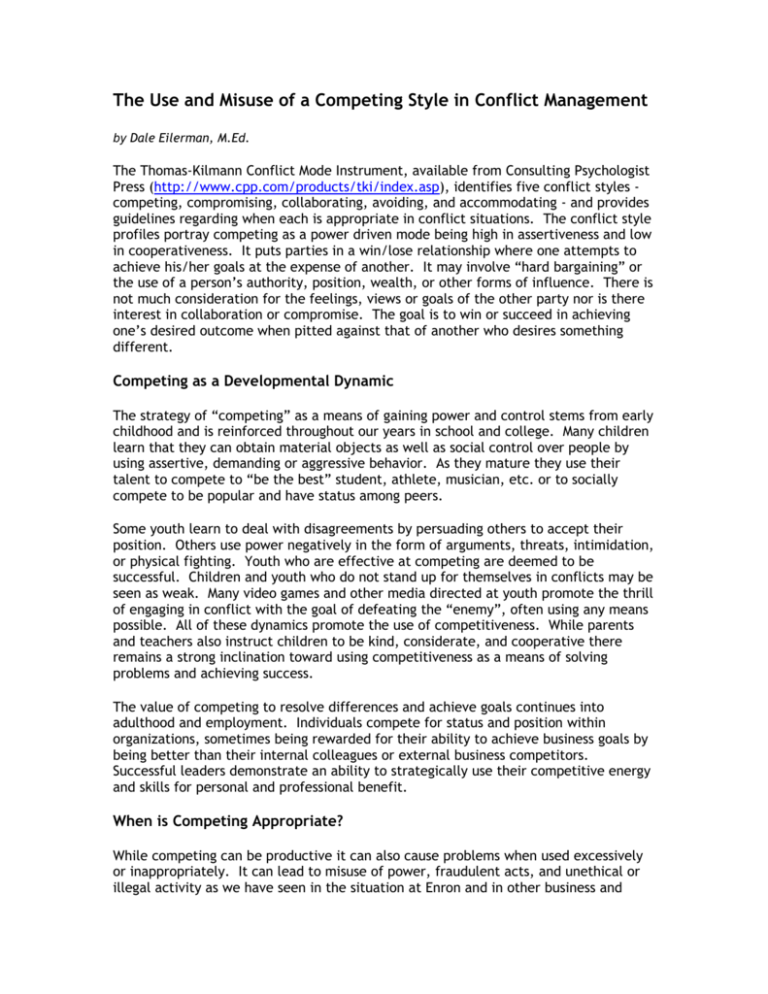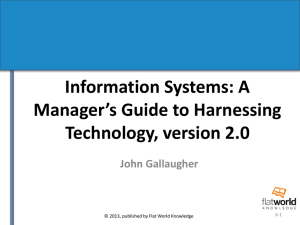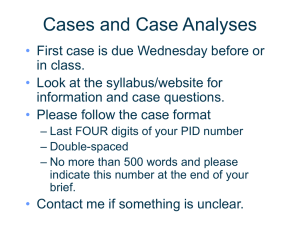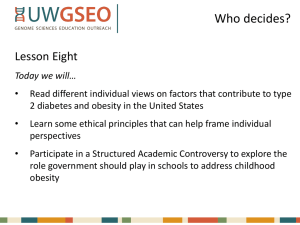The Use and Misuse of Competing Styles
advertisement

The Use and Misuse of a Competing Style in Conflict Management by Dale Eilerman, M.Ed. The Thomas-Kilmann Conflict Mode Instrument, available from Consulting Psychologist Press (http://www.cpp.com/products/tki/index.asp), identifies five conflict styles competing, compromising, collaborating, avoiding, and accommodating - and provides guidelines regarding when each is appropriate in conflict situations. The conflict style profiles portray competing as a power driven mode being high in assertiveness and low in cooperativeness. It puts parties in a win/lose relationship where one attempts to achieve his/her goals at the expense of another. It may involve “hard bargaining” or the use of a person’s authority, position, wealth, or other forms of influence. There is not much consideration for the feelings, views or goals of the other party nor is there interest in collaboration or compromise. The goal is to win or succeed in achieving one’s desired outcome when pitted against that of another who desires something different. Competing as a Developmental Dynamic The strategy of “competing” as a means of gaining power and control stems from early childhood and is reinforced throughout our years in school and college. Many children learn that they can obtain material objects as well as social control over people by using assertive, demanding or aggressive behavior. As they mature they use their talent to compete to “be the best” student, athlete, musician, etc. or to socially compete to be popular and have status among peers. Some youth learn to deal with disagreements by persuading others to accept their position. Others use power negatively in the form of arguments, threats, intimidation, or physical fighting. Youth who are effective at competing are deemed to be successful. Children and youth who do not stand up for themselves in conflicts may be seen as weak. Many video games and other media directed at youth promote the thrill of engaging in conflict with the goal of defeating the “enemy”, often using any means possible. All of these dynamics promote the use of competitiveness. While parents and teachers also instruct children to be kind, considerate, and cooperative there remains a strong inclination toward using competitiveness as a means of solving problems and achieving success. The value of competing to resolve differences and achieve goals continues into adulthood and employment. Individuals compete for status and position within organizations, sometimes being rewarded for their ability to achieve business goals by being better than their internal colleagues or external business competitors. Successful leaders demonstrate an ability to strategically use their competitive energy and skills for personal and professional benefit. When is Competing Appropriate? While competing can be productive it can also cause problems when used excessively or inappropriately. It can lead to misuse of power, fraudulent acts, and unethical or illegal activity as we have seen in the situation at Enron and in other business and political events in the news. Truly successful people develop the judgment and skills to use competitiveness effectively and appropriately. Competing is an appropriate form of dealing with conflict when used in the following situations: When a quick decision and action is needed. When the outcome is critical and cannot be compromised. When you know you are right and are doing the correct thing. In emergencies or when safety is a concern. When being right matters more than preserving the relationship with the other party. When important but unpopular actions are needed such as cost-cutting, downsizing, enforcing rules, or administering discipline. When one’s position, authority, or rights are being challenged. When implementing strategic change and strong, confident leadership needs to be demonstrated. When used inappropriately competing in conflict situations can lead to negative consequences such as: When it strains relationships leading to resentment and retaliation. When it causes intimidation which inhibits important communication, discussion of alternative ideas and attempts at problem solving. When collaboration or compromise would lead to a better exchange of information and better decisions or outcomes. When personal drive for power and control overrides the best interests of the organization. When it results in diminished commitment and support from staff. When it is indicative of a highly competitive personality trait resulting in overuse, causing a person to not recognize when it is important to quit or take another stance. When “winning at all costs” results in harm to people or the organization. When the personal relationship is more important than the issue at stake. Myers-Briggs Type and the Preference for Competing Research using the Myers-Briggs Type Indicator® shows that individuals with consistently competitive personality styles tend to be males who are extrovertedsensing-thinking-judging (ESTJ) or extroverted-intuitive-thinking-judging (ENTJ). Females are less likely than males to have a predominantly competitive personality style. Compared to males, similar type ESTJ and ENTJ females are more likely to have a preference for a compromising approach to conflict. This is probably due to the socialization and traditional roles of females in our society. Competitive males are often characterized in positive terms such as "persuasive" or "powerful" while equally competitive females may be viewed negatively as "demanding" or "aggressive". Individuals whose dominant conflict style is competing tend to see differences among people in dichotomies - skilled/unskilled, right/wrong, winner/loser, competent/incompetent, etc. They usually believe that they are justified in their position and support those who agree with them while opposing those who disagree. Myers-Briggs research suggests that people who like to be competitive in addressing differences approach problems objectively, using facts and data, and are not inclined to be very concerned about the subjective impact of the outcome on the party who loses. They tend to place high importance on achieving their goals even if it has a negative effect on their relationships. They also like to be decisive and do not want to waste time in considering alternatives. Interacting with Competitive People If you find that you, personally, typically become competitive when facing a disagreement or conflict you may want to: Take time to consider whether competing is the appropriate mode, weighing the pros and cons. Make an effort to listen and be open to alternative proposals, giving them respectful consideration. Evaluate the possible impact of all options under consideration. Be honest with yourself regarding any personal or historic relationship problems that may be impacting your feelings and beliefs about the disagreement. Recognize that your desire to be competitive may have a negative impact on your relationship with the person you are in disagreement with. In attempting to address a conflict with another person who differs with you and takes a competitive position it may be helpful to do the following: Allow the person to first thoroughly explain their position, asking clarifying questions. Summarize and repeat what you have heard to assure mutual understanding. Acknowledge the parts that you agree with. Ask the party to carefully listen to your position, clarifying points of agreement and disagreement, using logic and data to support your perspective. Consider having both positions put into writing for review and consideration. Minimize discussion or expression of feelings or subjective elements unless the other party seems open to this perspective. Point out the mutual benefits of a decision that involve collaboration or compromise if this is an option. Help the other party to understand how your position will benefit him/her and how they can gain from agreement with your proposal. If necessary, calmly inform the other party that you have the power, influence, or ability to win a power contest and that he/she will be better off not to continue to compete over the outcome of the decision that needs to be made. When working with individuals or groups as a neutral third party or mediator it is helpful to get the parties to consider the points made above. It is possible that one party will be in a relative power position over another, such as a boss vs. employee or a provider vs. consumer. In these situations the mediator must work to be neutral yet balance the power relationship so that each side effectively presents their case and hears that of the other. Helping the parties in conflict to understand the facts as well as the impact of the disagreement may also move them toward conciliation. After listening to each other competing may still be the conflict mode of choice for one or both parties, or they may elect to take another approach if they determine that it will be more productive. Conclusion It is clear that the use of competing to manage conflicts and differences can have both positive and negative implications. It is a powerful and effective approach which can be very successful. However it is important to know when and how to use competing as a conflict management style. Proper use of competing may produce constructive outcomes while misuse of competing can lead to new problems. Being mindful of this can help us to be more productive personally and professionally. Biography Dale Eilerman operates Conflict Solutions Ohio working with individuals and organizations to improve performance. He specializes in the dynamics associated with the management of differences and conflict and provides consultation, training, coaching, team-building, and conciliation work including mediation. Dale earned a Masters Degree in Counseling from the University of Dayton and a Liberal Arts degree from Earlham College. He is a part-time instructor at the University of Dayton and the Supervisor of Training and Development for a behavioral health organization in Dayton, Ohio. He can be contacted at 937.219.4996 or dale@conflictsolutionsohio.com.




